Canadian News November 20, 2019
Cannabis Market Brings Promo Challenges
Legalized recreational marijuana in Canada is going through growing pains, while the U.S. government continues to deliberate over federal legalization.
It’s been just over a year since Canada legalized recreational marijuana as the U.S. government continues to deliberate over federal legalization. The market in both countries continues to present challenges and opportunities for government representatives, legal producers, consumers and the promo industry.
On Nov. 20, the U.S. House Judiciary Committee passed the Marijuana Opportunity, Reinvestment and Expungement (MORE) Act in a 24-10 vote, with two Republicans joining their Democratic colleagues to support the bill, which would deschedule cannabis (currently categorized as a Schedule I drug), clear the criminal records of those with prior marijuana convictions and implement a 5% tax on the drug that would go to communities affected by drug abuse. It must next move to the House floor, and then the Senate, where its future is uncertain.
BREAKING: For the first time, a congressional committee approved a bill to end federal marijuana prohibition, 24-10 vote on the #MOREAct in the House Judiciary Committee. https://t.co/PL54VatCdD
— Kyle Jaeger (@kylejaeger) November 20, 2019
Meanwhile, in the Great White North, legalization had been a campaign promise of Prime Minister Justin Trudeau in 2015. After more than a year of wrangling among bureaucrats, law-makers, producers, advertisers and consumers, it became a reality last fall.
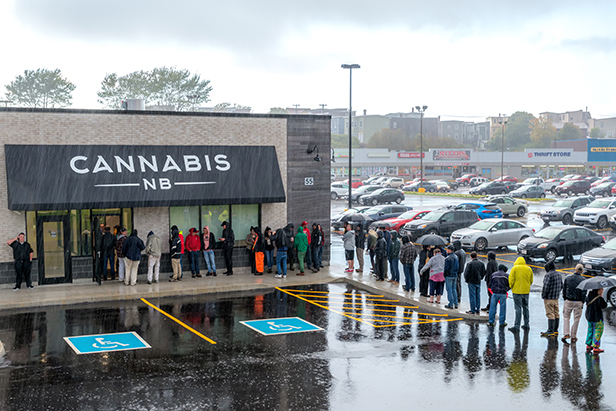
Customers wait outside a legal Cannabis NB store on the day of legalization in 2018.
At the time, the promo industry largely expressed a cautious “wait-and-see” attitude, since the mechanisms for compliance enforcement and restrictions on advertising were vague. “It’s still really gray,” Scott Hulbert, managing director of ideavation (asi/229801), told ASI Canada at the time. “It’s a moving target, as far as legalities, restrictions and advertising opportunities. Will it be like tobacco, which is very restricted in its advertising, or alcohol, which has been given more of a carte blanche? We just don’t know.”
The first wave of legalization only included dry flowers or buds, tinctures and capsules. Next month, “legalization 2.0” officially goes into effect – this includes edibles, beverages and vaping products. But the allowable branding for products so far has been similar to tobacco rather than alcohol, and that’s made it difficult for many promo firms to break into the market.
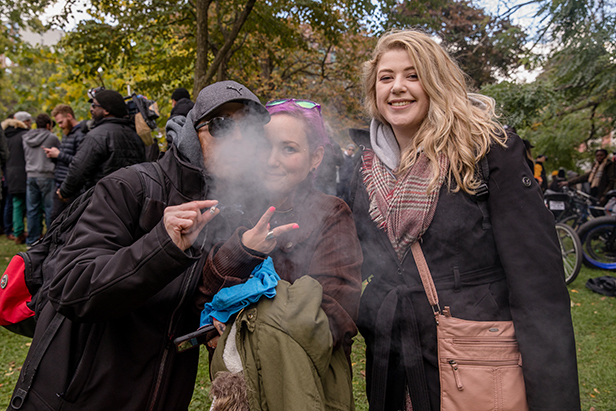
Canadians celebrate Cannabis Legalization Day in Toronto.
The inner workings of the legal market have also presented obstacles that make it difficult for promo companies to grow their cannabis client accounts. A high-profile dip in stock took place last week, when public cannabis companies Canopy Growth, Aurora Cannabis, Cronos Group and Tilray all reported significant declines. Stock in Canopy Growth, the world’s most valuable cannabis company, fared the worst, falling 14.4% on Nov. 14. In fiscal Q2, the company lost 1.08 Canadian dollars per share, with a total net loss of CA$374.6 million, and net sales fell 15% quarter-over-quarter to CA$76.6 million. Both losses were larger than initial estimates.
“The last two quarters have been challenging for the Canadian cannabis sector as provinces have reduced purchases to lower inventory levels, retail store openings have fallen short of expectations and Cannabis 2.0 products are yet to come to market,” Canopy Growth CEO Mark Zekulin, who will be stepping down at the end of 2019, said in a statement. During a recent earnings call, Zekulin said, “At the risk of oversimplifying, the inability of the Ontario government to license retail stores right off the bat has resulted in half the expected market in Canada simply not existing.”
It’s just one of a litany of complaints by cannabis companies, many of which were backed by venture capital in the heady first days of legalization. Arguably, government bureaucracy’s involvement with the market since legalization – especially licensing procedures and testing – have slowed it down, so that legal distribution systems continue to wrestle for market share with the illegal industry.
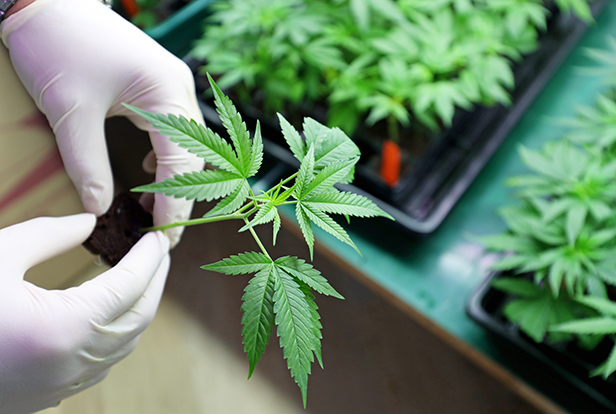
Legal producers have been faced with many obstacles, including slow government licensing processes and too much supply.
Meanwhile, the tedious licensing process required of retail locations in the provinces is causing a glut of supply that’s not being sold, since producers are growing but consumers are having a hard time accessing product. Currently, in Ontario, there are just 25 retail stores, though an additional 50 are expected to open next year.
Complicating the second phase of legalization next month, which includes vaping products, is the recent concern over deaths linked to vaping. As of this writing, 42 vaping-related deaths worldwide have been reported, and instances of lung injury numbered at more than 2,100. The CDC in the U.S. said fatalities have occurred in 24 states, and many of the incidents may be linked to vitamin E acetate, a vaping oil thickener often present in the illegal market.
While the future remains to be seen for the Canadian market as it works to hit its stride, there are those who are optimistic about its future. The Brightfield Group, a market research firm for the cannabis industry, told CNN it estimates that it will total CA$3.7 billion by the end of 2020, more than double the expected value of CA$1.6 billion by the end of 2019. Sales of additional products as part of the second phase of legalization will add up to CA$900 million next year, they report. But all products will still be subject to government regulation concerning production, formulation, testing requirements and quality, Health Canada confirmed to CNN.
Meanwhile, branding product has posed a challenge for legal producers and their creative teams, including promotional product distributors. There was even talk early on in Canada of a complete ban on marijuana merch, but the Canadian House ultimately rejected it.
The passed Cannabis Act included restrictions on advertising that would keep cannabis packaging plain and regimented, more akin to tobacco products than alcohol. Marketers aren’t allowed to create any imagery that could possibly appeal to minors, portray the product in a glamorous or exciting way, use any testimonials or celebrity endorsements, or create mascots.

Los Angeles-based pop-up Museum of Weed by Weedmaps sold these streetwear-inspired joggers.
An amendment to the Act that went into effect last month stiffens the advertising limitations. Imprints on branded products are limited to 300 square centimeters, and the height of the lettering may not be more than 4 centimeters. While basic products like T-shirts and hats can be used, the legislation only allows one brand element to be shown on each item, in order to “reduce the impact of the promotion.” Penalties can reach $1 million.
At the same time, while the market in the U.S. looks poised to grow, it’s also come with its own challenges. Recreational pot hasn’t yet been legalized nationwide, only in 10 states and the District of Columbia, though that discussion continues. Governor Phil Murphy of New Jersey continues to push for legalization there.
But, as is the case in Canada, legalization hasn’t led to widespread accessibility to legal product. In California, for example, which legalized recreational cannabis in 2016, the legal market (the world’s largest, at $3 billion) is still competing with the illegal one, valued at $9 billion. The industry has seen massive layoffs due to slow market growth, heavy taxation, slow state licensing procedures and municipal prohibitions on commercial activity, among other factors.
“It’s pretty tough just even for the regulators right now,” Lori Ajax, head of California’s Bureau of Cannabis Control, said at a recent industry forum. “These challenges just keep coming at us and to the industry.” She added, “We don’t want to confuse you, but, I guess, we’re confused too. We’ve got to un-confuse things.”
The illegal market has also caused serious environmental disturbances. On Nov. 18, the Associated Press reported that authorities in California are currently assessing the damage that illicit growers, allegedly tied to an international drug trafficking ring, have wrought in rural Northern California, in an area known as the Emerald Triangle for its reputation as a cannabis-producing region since the 1960s. Called a “trespass grow,” where illegal growers use land (much of it public) to cultivate marijuana, authorities found at this particular site almost 9,000 plants, thousands of pounds of trash, over three miles of plastic irrigation piping and bottles of carbofuran, a prohibited neurotoxicant used here as a rodenticide that has also killed owls, fish and mountain lions. Just a quarter-teaspoon can kill a 300-pound bear.
Officials estimate that 70% of California’s illegal market comes from trespass grows, and the state just doesn’t have the resources to address them all.
“These places are toxic garbage dumps,” Rich McIntyre, director of the Cannabis Removal on Public Lands Project, told the AP. “Food containers attract wildlife, and the chemicals kill the animals long after the sites are abandoned. We think there’s a public health time bomb ticking.”
The legal market in California has also had to contend with the fallout surrounding vaping injury and deaths in recent months, and hasn't been able to take advantage of financial services that would help companies with business growth: Many banks in the U.S. still don’t offer services to producers, citing concerns about ending up on the wrong end of government regulation. The Secure and Fair Enforcement (SAFE) Act, introduced in March to Congress, would protect banks from possible prosecution for accepting funds generated through the growth and sale of marijuana. It was sent to the Senate in September, where it awaits further deliberation.
Meanwhile, Colorado, one of the first two states along with Washington to legalize recreational marijuana, is seeing huge revenues in the cannabis market. In June, the state announced that it had surpassed $1 billion in revenue from pot, the first state to do so. And companies have made approximately $6.5 million in sales since 2014, with April and May of this year the most lucrative since legalization in 2012. But that growth has taken time; in 2012, only 30 stores were open for business. That resulted in legal prices increasing and a thriving black market, but as more stores opened and licenses were issued, the industry there largely stabilized and eventually became profitable.
With all the uncertainty surrounding the future of the industry, there are still some companies in the promo industry that have capitalized. Alco Prevention Canada (asi/30166) in Laval, QC, sells the Cannabis Verdict drug test that’s been popular among companies looking to quickly test employees in high-demand work situations, like construction and transportation. “We’ve seen a double-digit rise in sales on these test kits this year,” general director Stéphane Maurais told ASI Canada this week. “We also have clients offering them for road safety campaigns and students.”
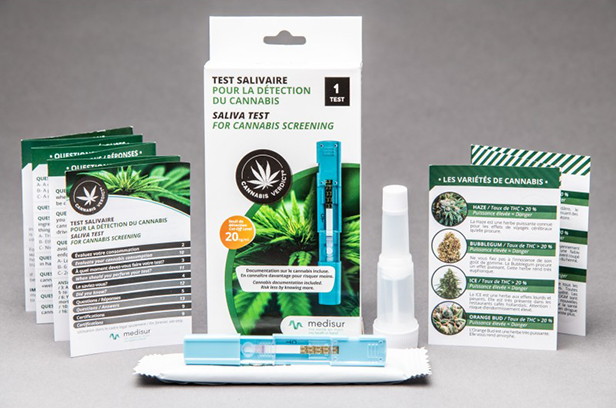
Alco Prevention Canada’s Cannabis Verdict testing kit has proven popular with construction, transportation, road safety and education clients.
Michael Shein, president of Polar Promotions (asi/138454) in Calgary, AB, and one of Counselor’s fastest-growing Canadian firms this year, told ASI Canada his company is doing what it can to serve clients in a choppy market.
“I was very disappointed in how the Canadian government legalized cannabis,” he said. “The government isn’t very good at running businesses. There was slow deployment of permits and retail location openings, and the supply chain, retail and pricing models also developed slowly, creating an imbalance and a flawed market.”
Meanwhile, promo companies are finding it difficult to bring creative solutions to legal producers looking to differentiate and legitimize their brand in the marketplace. Polar Promotions, Shein said, is “handcuffed” by the law’s advertising and can’t sell cannabis-specific items, like pipes, bongs or rolling papers, in Canada. They’ve mostly sold more universal items like apparel, bags and storage cases for cannabis clients.
However, Shein does think that after the market’s growing pains, in both Canada and the U.S., the industry will hit its stride. The legal market will eventually be able to better compete with the illegal one, more retail locations will open and advertising will evolve. “The market is only 14 months old,” Shein said. “It will solve its problems and become a legitimate industry, but all that will take time. The U.S. market is also still in its infancy stage, but I believe it will figure it out as time goes on.”
Ryan Tickle, vice president of sales at Cannabis Promotions (asi/42996) in St. Petersburg, FL, told ASI Canada this week that, despite the doom and gloom, the cannabis industry is actually on a healthy growth trajectory. “We’re now in the ‘early kid’ stage with cannabis,” he said. “You still have to watch it and hold its hand, but every time you look at the numbers every month or quarter, you can see how much it’s grown. Although stocks have gone down in recent weeks, most of those companies’ sales have at least doubled over the last year.”
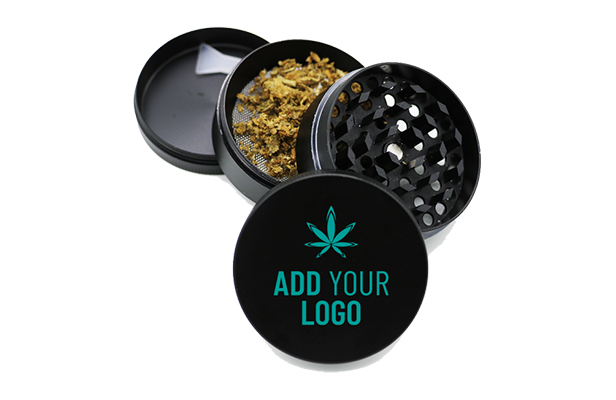
Cannabis Promotions in Florida offers pot-specific items like this grinder (CGNDR-M50). The company is poised to meet legal demand by staying informed on government regulations.
Tickle is also a proponent of government regulation of cannabis that will make it safer and more legitimate. “One of the biggest opportunities for the promotional and marketing industry is to understand these laws and assist companies with regulation and branding,” he said. “When people can provide the expertise for branding and dispensaries can focus on growing, that’s beneficial for everyone. Cannabis companies have premium-priced products and like to use premium packaging.”
As the market experiences growing pains, Tickle is sure the market is poised to grow exponentially. “As more states and countries legalize it and issue more dispensary licenses, prices will rapidly decline, which will help take more market share from the black market. That’ll be a very exciting time. And once commerce is allowed between geographic areas, there will be even more sales and growth.”
